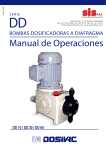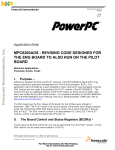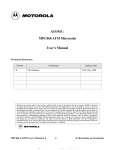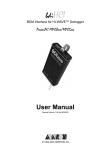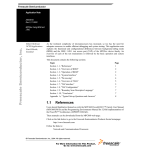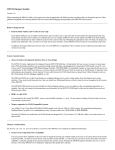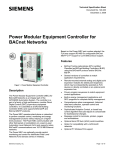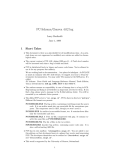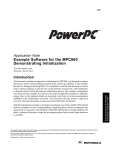Download Application Note
Transcript
Order this document by AN2131 Freescale Semiconductor 07/99 Application Note MPC860 Board Design Checklist Netcomm Applications Freescale, Austin, Texas Introduction When integrating MPC8xx family members into an application, it may be helpful to go through the following design checklist. This checklist outlines a number of common problems with respective solutions that have been found while debugging real MPC860 applications. © Freescale Semiconductor, Inc., 2004. All rights reserved. Checklist Version, Mask The first version of the MPC860 was called rev 0. Metal fixes were made to this version to create versions such as rev 0.1. The first full layer change was revision A. Subsequent metal fixes add numbers to the revision, such as A.2. © Freescale Semiconductor, Inc., 2004. All rights reserved. © Motorola Inc., 1998. All rights reserved. For More Information On This Product Go to: www.freescale.com MPC860 Board Design Application Note Freescale Semiconductor, Inc... ™ Freescale Semiconductor, Inc. Choosing Oscillators versus Crystals If you can afford the power dissipation of using an oscillator rather than a crystal, choose an oscillator. Crystal circuits must often be tweeked after the die goes through a geometry shrink. Using both Oscillators and Crystals Freescale Semiconductor, Inc... Crystal oscillators and crystals can be used together on the MPC860, however do not use the crystal on the EXTAL and XTAL pins and leave the oscillator free-running into the EXTCLK pin as this will cause excessive jitter. Rather, externally gate the clock of the oscillator to the EXTCLK pin while the crystal is in use. It’s good design practice that if you’re not using a crystal, ground the EXTAL pin. Clock Circuit Layout Locate the crystal within 0.5 inches of the MPC8xx. The closer the better. The XFC capacitor should be physically as close as possible to the MPC8xx as well. VDDsyn Filter Use a LC filter on the VDDsyn pin instead of a RC filter. Please refer to the MPC860ADS schematic for a good example of a proper circuit. 5 Volt Friendly Signals Although the MPC8xx does support 5V inputs, please note that EXTAL and EXTCLK are not 5 Volt friendly inputs. Inputs on those signals are limited to 3.3V. Power Supply 2.2V Confusion Connect 3.3V to the internal logic VCC pins (called VDDL) and all other power pins on the MPC8xx and not 2.2V. The use of 2.2V on VDDL was illustrated in one of the example user manual drawings, but is only allowed if a special version of the MPC8xx is purchased. At the time of writing this document, this special 2.2V version had not been introduced, so be sure to check with your local Freescale representative for availability, if this mode is required. Memory, DRAM Not all DRAM SIMMs are created equal. With Freescale SIMMs the signal integrity on the DRAM control and address lines look good. With other manufacturers, series damping resistors need to be used. The MPC860ADS board was designed for Freescale SIMMs, and therefore does not show series damping resistors. 2 For More Information On This Product, Go to: www.freescale.com Freescale Semiconductor, Inc. Memory, DRAM, External Master If an external master device is accessing DRAM using the MPC8xx memory controller, the burst address pins (BADDR(28:30)) on the MPC8xx should be connected through the multiplexer, and not directly to the DRAM. How Many Layer Board? Freescale Semiconductor, Inc... It is recommended to use one ground plane, one 3.3V VCC plane, and one 5.0V VCC plane (if 5V parts exist in the system). In addition at least four signal planes would normally be used to ensure easy routing to/from the MPC860. Analog Power Supply The MPC860ADS board design pays particular attention to the power planes in the area of the PLL power. The VDDsyn pin is routed to a via that punches down to a mini plane (really a peninsula on a signal layer) which is decoupled from VSSsyn with 10UF and 0.1UF parallel caps and also attaches to the 3.3 Volt plane through a 8.2mH inductor. The 3.3 and 5 volt planes have a keepout in the PLL power area. Separate the PLL VSSsyn from Global ground by means of a split in the plane with a connection point as close to the supply as possible. On other layers, signals are kept out of this area. Also, the PLL loop filter and decoupling caps should be placed as close to the MPC8xx as possible. Pullups on the Data Bus Putting pullups on the Data Bus has implications on the initial configuration of the MPC8xx, since there is a mode whereby the part could sample the data bus during reset to determine its initial configuration. If you choose to put pullups on the data bus, make sure that the RSTCONF* pin is tied high, otherwise the default MPC8xx configuration values will be overwritten with ones from the pullups on the data bus. Alternatively, you can put pullups on the data bus (for the purpose of using them as bus keeps), if you drive all of the configuration pins actively high or low (as appropriate) during reset, as described below. The pullups can be terminated to either 5 or 3.3 volts and the value is left up to the designer. Hard Reset Configuration Word Pins The data bus is sampled at reset to determine the initial configuration of the MPC8xx if the RSTCONF* pin is tied low. Ensure that the correct values are driven to the bus during the PORESET and HRESET periods. For any data pins that the user wishes to configure as 1’s (i.e. where the default configuration is not appropriate), do not expect pullups to be sufficient. Use active drivers to drive 1’s and 0’s if pullups are already being used on the data bus. The drivers should then be disabled following reset. Powerup Reset Circuit There is no power up detector on the MPC8xx like there was on the 68360. To construct a simple circuit, hang a diode, cap and resistor network on PORESET line. A more robust (expensive) solution is to use a power on reset chip monitoring the power plane. Hard reset is a bidirectional signal and if used, needs to be driven with an open collector (open drain) device. Diodes should be used on the reset inputs to cause For More Information On This Product, Go to: www.freescale.com 3 Freescale Semiconductor, Inc. sharp transistions of those signals. The 860ADS board has an excellent treatment of the reset circuit, and should be followed as a guide. MPC860 Driving SRESET* The MPC8xx can drive the soft reset pin (SRESET*) as an output. It is driven by the MPC8xx any time that the PORESET* lines or the HRESET* line is asserted and also if a RESET command is delivered to the debug port. Freescale Semiconductor, Inc... So You Need a Halt Signal? The MPC860 does not support a Halt signal. One suggestion we can make for board designers that have to have one, is to monitor the AT3-0 pins for an absence of activity. MODCK Pins The MODCK pins become outputs after reset. To configure them, drive them with three state buffers enabled with HRESET*. Although MODCK is latched on rising edge of PORESET*, this is a slow edge so use HRESET* as the enable. Byte Lane for Boot EPROM If eight bit wide memory/EPROM is used, attach the device to byte lane zero (D0-D7). Note that in PowerPC terminology, D0-D7 is the highest order byte lane on the data bus, and D0 is the highest order pin of that byte lane. D0-D7 corresponds to write enable 0 (WE0*) and Byte Select A or B 0 (e.g. BS_A0*). D0-D7 --> D15-D8 --> D23-D16 --> D31-D24 --> WE0* --> BS_B0* WE1* --> BS_B1* WE2* --> BS_B2* WE3* --> BS_B3* or BS_A0* or BS_A1* or BS_A2* or BS_A3* Highest order data pin: D0. Lowest order data pin: D31. Address Pins The highest order address pin is A0. The lowest order address pin is A31. Check that the MSB (0) and LSB (31) are correctly connected. In a byte access, all 32 address pins are valid. In a 32-bit word access, only the upper 30 address pins are used (A0-29). A30 and A31 should both be zero. 4 For More Information On This Product, Go to: www.freescale.com Freescale Semiconductor, Inc. Address/Data Nomenclature We recommend that you build your schematics in accordance with the PowerPC terminology. If you try to "rename" your address or data bus pins to make them 68K friendly (e.g. by renaming A0 to be A31), you will probably end up with mistakes on your board design. Chip Select Double Drive Freescale Semiconductor, Inc... It is possible to get more drive capability on CS2* and CS3* by having these signals output on 2 pins each. CS2* can be driven on the normal CS2* pin and GPL_A2*. CS3* can be driven on the normal CS3* pin and also GPL_A3*. Note that the CS* pins can also be used as RAS* lines, where drive capability often is critical in gaining the last nanosecond from the memory system. The double drive capability is programmed in the SIUMCR. Be Careful of R/W* A R/W* pin is provided on the chip, but its timing is not appropriate for all memory types. Remember that the R/W* timing is fixed, and the WE0-3* signals are usually a better choice. If the WE0-3* signal timing is not suitable, the more flexible UPM machine of the memory controller can be used to give precise timings on these signals. Put a 10-pin Header for the Development Port on Your Board The Development Port section of the user’s manual describes a 10-pin header that should be included on your board. Physically locate the 10 pin connector as close as possible to the processor to minimize trace length and cross coupling of noise onto the BDM signals. Do not run high speed clocks or signals adjacent to the BDM communication signals.When your boards arrive, you can begin initial testing via this port. The MPC860ADS board describes a feature whereby you can connect your 10-pin header to another 10-pin header on our ADS board. By connecting our ADS board to a PC, you can use our PC hosted debugger to begin to manipulate registers on the target board, just as you would on our ADS board. (Remember that the MPC8xx device on the ADS board must be removed for this mode of operation, and use the shortest possible cable between the ADS and your target). In addition, other thirdparty tools use this 10-pin header for their debugger capability. Debug Port Interface The DSDI and DSCK pins are configured during reset to select certain modes of the development port system interface. If the user wishes to pull the DSCK pin low, then a 1Kohm pulldown should be used to make sure that low logic levels are recognized on all versions of the MPC8xx. DSDI should have a pullup to be on the safe side ( there is an internal pullup ). For the TA*, TEA* and BB* signal pins, use a 1k ohm pull-up resistor. If not you will get erratic operation. For More Information On This Product, Go to: www.freescale.com 5 Freescale Semiconductor, Inc. PCMCIA Buffers Not Needed Although the MPC8xx manual shows buffers in the PCMCIA design example, it is noted that such buffers on the address or data bus are only required if the address or data bus is heavily loaded, a 2 PCMCIA slot system is designed, or the board requires protection from hot plug-in of PCMCIA cards. IDMA, Memory-to-Memory Freescale Semiconductor, Inc... If the user desires to use the IDMA in memory-to-memory mode, the DREQ* pin must be asserted. It is possible to ground the pin or use a parallel I/O pin to selectively enable the DREQ* function. Using the parallel I/O pin is preferable, to save the added overhead of the CPM RISC polling the IDMA buffer descriptors to see if the valid bit has been set. Port Pins, Pullups The parallel port pins on the MPC860 do not have internal pullups or pulldowns. Unused parallel I/O pins may be configured as outputs after reset and left unconnected. Unused Input Pins Unused inputs should be tied high or low, but not left floating. Unused inputs may be tied directly to VCC or GND or through pullups or pulldowns to VCC or GND. For most pins, VCC can be either 3.3V or 5.0V. Unused Output Pins Unused output pins may be left unconnected. Erratic device operation following power up Ensure the TRST signal is connected as recommended in the rev. 1 version of the users manual as follows: If both the TAP (Test Access Port) and low power mode are NEVER used, connect TRST to ground. If the TAP or low power mode is used, connect TRST to PORESET. If power down mode ( the lowest power mode, where Vddh is disabled) is used, connect TRST to PORESET through a diode ( anode to TRST, cathode to PORESET). Do NOT connect TRST to HRESET as was previously recommended in certain documentation. Additional information on these areas is detailed in the Rev.1 version of he MPC860 Users Manual (UM). Please review sections 13.3 and 13.4 for full details. 6 For More Information On This Product, Go to: www.freescale.com Freescale Semiconductor, Inc. Controlling Excessive Rise Time on Negation of PORESET* To control excessive rise time on negation of PORESET* with an emulator installed, pullup the PORESET* line with a 1-K ohm pullup resistor. Using an 860T or 860EN: Locate the processor and ethernet controller as physically close together as is feasible. Provide for a series resistor option to fine tune clock ringing on RCLK and TCLK. Freescale Semiconductor, Inc... UPM Design Hint When Using an Emulator It may be necessary to change UPM values when using a non-DPI ( Debug Port Interface ) connection method because of the impedance impact of installing an emulator probe or other line loading device into a target. Easier Testing/Debugging Hint Wherever possible place pads on the opposite side of the board from the processor for a possible future mirror probe connection. MPC850 and MPC823 external masters The 850 and 823 have only 26 externally visible address bits. Therefore, external masters should only address the range from hex 0000 0000 to x3FF FFFF if the external master uses the memory controller or any of it’s functions on the 850/823. The bits from an external master will be seen as 0’s by the memory controller. Internally the address bits are present and can be addressed for MMU and cache functions from the PPC core. CLKOUT Signal The drive capability of the CLKOUT signal is modest. If necessary, use a clock driver/distribution device to redrive this signal. The MPC974 ,for example, can be configured as a ( near ) zero delay buffer. PLL Loop filter values require careful selection, and placement. Power Supply decoupling for the PLL requires attention as well. Chip Select 0 Ensure that CS0 is connected to the boot memory device. For More Information On This Product, Go to: www.freescale.com 7 Freescale Semiconductor, Inc. Using FLASH Devices Ensure the correct FLASH bit ordering for the correct programming algorithm is connected. HRESET*, SRESET*, PORESET*, and TA* Signals Provide low resistance value pull-ups (1K to 4.7 K) on the following signals: HRESET*, SRESET*, PORESET*, and TA*. Freescale Semiconductor, Inc... How to Reach Us: Home Page: www.freescale.com E-mail: [email protected] USA/Europe or Locations Not Listed: Freescale Semiconductor Technical Information Center, CH370 1300 N. Alma School Road Chandler, Arizona 85224 +1-800-521-6274 or +1-480-768-2130 [email protected] Europe, Middle East, and Africa: Freescale Halbleiter Deutschland GmbH Technical Information Center Schatzbogen 7 81829 Muenchen, Germany +44 1296 380 456 (English) +46 8 52200080 (English) +49 89 92103 559 (German) +33 1 69 35 48 48 (French) [email protected] Japan: Freescale Semiconductor Japan Ltd. Headquarters ARCO Tower 15F 1-8-1, Shimo-Meguro, Meguro-ku, Tokyo 153-0064 Japan 0120 191014 or +81 3 5437 9125 [email protected] Asia/Pacific: Freescale Semiconductor Hong Kong Ltd. Technical Information Center 2 Dai King Street Tai Po Industrial Estate Tai Po, N.T., Hong Kong +800 2666 8080 [email protected] Information in this document is provided solely to enable system and software implementers to use Freescale Semiconductor products. There are no express or implied copyright licenses granted hereunder to design or fabricate any integrated circuits or integrated circuits based on the information in this document. Freescale Semiconductor reserves the right to make changes without further notice to any products herein. Freescale Semiconductor makes no warranty, representation or guarantee regarding the suitability of its products for any particular purpose, nor does Freescale Semiconductor assume any liability arising out of the application or use of any product or circuit, and specifically disclaims any and all liability, including without limitation consequential or incidental damages. “Typical” parameters which may be provided in Freescale Semiconductor data sheets and/or specifications can and do vary in different applications and actual performance may vary over time. All operating parameters, including “Typicals” must be validated for each customer application by customer’s technical experts. Freescale Semiconductor does not convey any license under its patent rights nor the rights of others. Freescale Semiconductor products are not designed, intended, or authorized for use as components in systems intended for surgical implant into the body, or other applications intended to support or sustain life, or for any other application in which the failure of the Freescale Semiconductor product could create a situation where personal injury or death may occur. Should Buyer purchase or use Freescale Semiconductor products for any such unintended or unauthorized application, Buyer shall indemnify and hold Freescale Semiconductor and its officers, employees, subsidiaries, affiliates, and distributors harmless against all claims, costs, damages, and expenses, and reasonable attorney fees arising out of, directly or indirectly, any claim of personal injury or death associated with such unintended or unauthorized use, even if such claim alleges that Freescale Semiconductor was negligent regarding the design or manufacture of the part. For Literature Requests Only: Freescale Semiconductor Literature Distribution Center P.O. Box 5405 Denver, Colorado 80217 1-800-441-2447 or 303-675-2140 Fax: 303-675-2150 [email protected] For More Information On This Product, Go to: www.freescale.com









